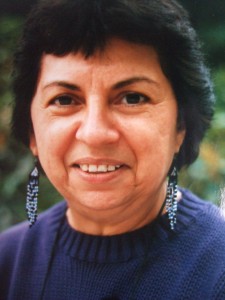 Gloria Evangelina Anzaldúa (1942-2004) was a scholar of Chicana cultural theory, feminist theory and queer theory. Her works include the co-editorship of This Bridge Called My Back: Writing by Radical Women of Color (1981) with Cherrie Moraga. The book is an anthology of poetry, fiction and essays by women of color. It marked an important intervention in feminist studies by bringing in different subjectivities and experiences and is considered pivotal in the development of Third World feminism. In 2002, Anzaldúa co-edited another anthology (with AnaLouise Keating) entitled ‘this bridge we call home’. Keating states that the reason for the second anthology was because of her dissatisfaction with the state of the feminist movement and sees the book as an invitation ‘to rethink the existing categories and invent new individual and collective identities, transformational alliance’ (Anzaldúa and Keating 2002: 20).
Gloria Evangelina Anzaldúa (1942-2004) was a scholar of Chicana cultural theory, feminist theory and queer theory. Her works include the co-editorship of This Bridge Called My Back: Writing by Radical Women of Color (1981) with Cherrie Moraga. The book is an anthology of poetry, fiction and essays by women of color. It marked an important intervention in feminist studies by bringing in different subjectivities and experiences and is considered pivotal in the development of Third World feminism. In 2002, Anzaldúa co-edited another anthology (with AnaLouise Keating) entitled ‘this bridge we call home’. Keating states that the reason for the second anthology was because of her dissatisfaction with the state of the feminist movement and sees the book as an invitation ‘to rethink the existing categories and invent new individual and collective identities, transformational alliance’ (Anzaldúa and Keating 2002: 20).
In her writings, Anzaldúa combines autobiography, poetry, historical narratives and myths. She not only moves seamlessly between these ‘genres’ but also between languages (English and Spanish) and also different variations of the languages. Thus, her writing itself is an act of questioning and transforming the boundaries and categories of ‘genres’. She uses the term autohistoria-teoria to describe this genre of writing that presents a non-linear history and includes personal narratives, factual accounts, myths and poetry.
She starts from her own personal experience of growing up on the US-Mexican border;
1,950 mile-long open wound
dividing a pueblo, a culture,
running down the length of my body,
staking fence rods in my flesh,
splits me splits me
me raja me raja (Anzaldúa 1987: 2)
The ‘U.S.-Mexican border es una herida abierta where the Third World grates against the first and bleeds’ (Anzaldúa 1987:3) and it is that herida abierta [open wound] that Anzaldúa tries to heal through her writing. From there she moves outward to ‘break down the subject-object duality’ the uprooting of which ‘is the beginning of a long struggle, but one that could, in our best hopes, bring us to the end of rape, of violence, of war’ (Anzaldúa, 1987: 80). She argues that ‘the borderlands are physically present wherever two or more cultures edge each other, where people of different races occupy the same territory, where the lower, middle and upper classes touch’ (Anzaldúa, 1987: preface).
She develops concepts that aim to transform binary constructions such as Borderlands, neplanta (the Nahuatl word for an in-between space), mestiza consciousness, new tribalism and Coatlicue state among many others. The aim is to ‘bridge’ the dividing line imposed by borders, labels and binary thinking. She elaborates on her approach by stating that; ‘categories attempt to contain, imprison, limit, keep us from growing. We have to constantly disrupt those categories and invent new ones. The new ones are good for a few years. [….]To me these concepts are very much in transition; they’re impermanent; they’re fluid, not fixed’ (Blake and Ábrego 1995). She sees the very act of writing as being liberating and transformative, it is through thinking and writing in ways that destabilise classificatory systems of knowledge that they can be transformed. Thus, language and writing are performative and ‘the ability of story (prose and poetry )to transform the storyteller and the listener into something or someone else is shamanistic. The writer, as shape-changer, is a nahual, a shaman’ (1987:66) and as a shaman, what Anzaldúa does is,
I pick the ground from which to speak
a reality into existence
I have chosen to struggle against
unnatural boundaries (Anzaldúa 2015)
ESSENTIAL READINGS:
Reuman, Ann E., and Gloria E. Anzaldúa (2000) “Coming into play: an interview with Gloria Anzaldua”, Melus, 25(2): 3-45.
Anzaldúa, Gloria (1987) Borderlands/La Frontera:The New Mestiza. San Francisco, CA: Spinsters/Aunt Lute.
“La Prieta” in Moraga, Cherríe, and Gloria Anzaldúa (1981) (eds.) This Bridge Called My Back: Writings by Radical Women of Color. Watertown, MA: Persephone Press, p.198-210.
FURTHER READINGS:
Anzaldúa, Gloria, and Analouise Keating (2002) (eds) this bridge we call home: radical visions for transformation. New York: Routledge.
Anzaldúa, Gloria (2015) Light in the Dark/Luz en lo Oscuro: Rewriting Identity, Spirituality, Reality. Durham and London: Duke University Press.
Blake, Debbie; and Ábrego, Carmen. “An Interview with Gloria Anzaldúa.” Iowa Journal of Cultural Studies (1995): 12-22.
Keating. AnaLouise (2005) (ed.) EntreMundos/ Among Worlds: New Perspectives on Gloria Anzaldúa. New York: Palgrave.
Keating, AnaLouise (2015) Introduction and Preface to Gloria Anzaldúa’s Light in the Dark/Luz en lo Oscuro: Rewriting Identity, Spirituality, Reality. Durham and London: Duke University Press.
Moraga, Cherríe, and Gloria Anzaldúa (1981) (eds.) This Bridge Called My Back: Writings by Radical Women of Color. Watertown, MA: Persephone Press.
Reuman, Ann E. (2000) Coming into Play: An Interview with Gloria Anzaldúa. MELUS, 25(2):
QUESTIONS:
How does Anzaldua’s writing challenge established modes of knowing?
How does Anzaldúa conceptualise the act of writing?
Submitted by Zeynep Gulsah Capan